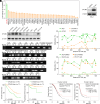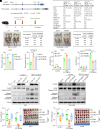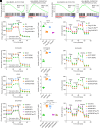OTUB2 silencing promotes ovarian cancer via mitochondrial metabolic reprogramming and can be synthetically targeted by CA9 inhibition
- PMID: 38701117
- PMCID: PMC11087800
- DOI: 10.1073/pnas.2315348121
OTUB2 silencing promotes ovarian cancer via mitochondrial metabolic reprogramming and can be synthetically targeted by CA9 inhibition
Abstract
Ovarian cancer is an aggressive gynecological tumor characterized by a high relapse rate and chemoresistance. Ovarian cancer exhibits the cancer hallmark of elevated glycolysis, yet effective strategies targeting cancer cell metabolic reprogramming to overcome therapeutic resistance in ovarian cancer remain elusive. Here, we revealed that epigenetic silencing of Otubain 2 (OTUB2) is a driving force for mitochondrial metabolic reprogramming in ovarian cancer, which promotes tumorigenesis and chemoresistance. Mechanistically, OTUB2 silencing destabilizes sorting nexin 29 pseudogene 2 (SNX29P2), which subsequently prevents hypoxia-inducible factor-1 alpha (HIF-1α) from von Hippel-Lindau tumor suppressor-mediated degradation. Elevated HIF-1α activates the transcription of carbonic anhydrase 9 (CA9) and drives ovarian cancer progression and chemoresistance by promoting glycolysis. Importantly, pharmacological inhibition of CA9 substantially suppressed tumor growth and synergized with carboplatin in the treatment of OTUB2-silenced ovarian cancer. Thus, our study highlights the pivotal role of OTUB2/SNX29P2 in suppressing ovarian cancer development and proposes that targeting CA9-mediated glycolysis is an encouraging strategy for the treatment of ovarian cancer.
Keywords: chemoresistance; metabolic reprogramming; ovarian cancer; tumorigenesis; ubiquitination.
Conflict of interest statement
Competing interests statement:The authors declare no competing interest.
Figures






References
Publication types
MeSH terms
Substances
Grants and funding
- 2021YFC2501000/MOST | National Key Research and Development Program of China (NKPs)
- 82030089/MOST | National Natural Science Foundation of China (NSFC)
- 82188102/MOST | National Natural Science Foundation of China (NSFC)
- 2021-I2 M-1-018/CAMS | Chinese Academy of Medical Sciences Initiative for Innovative Medicine ()
- 2021-I2 M-1-067/CAMS | Chinese Academy of Medical Sciences Initiative for Innovative Medicine ()
LinkOut - more resources
Full Text Sources
Medical
Research Materials

